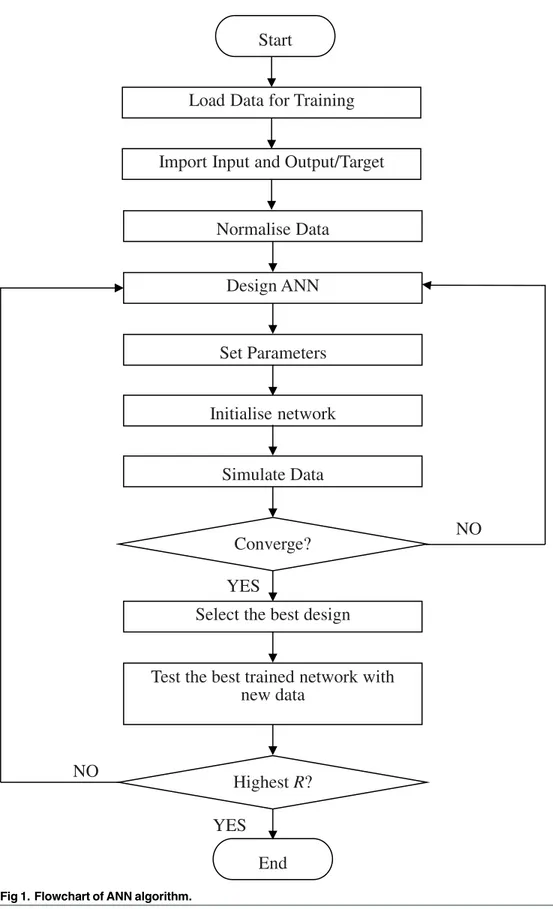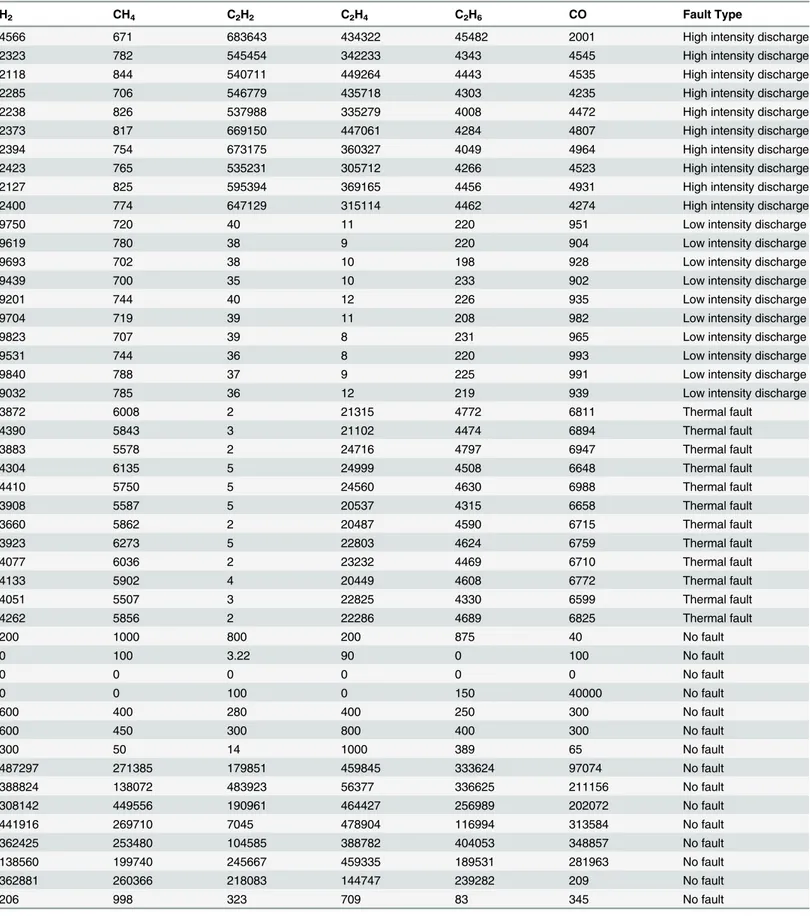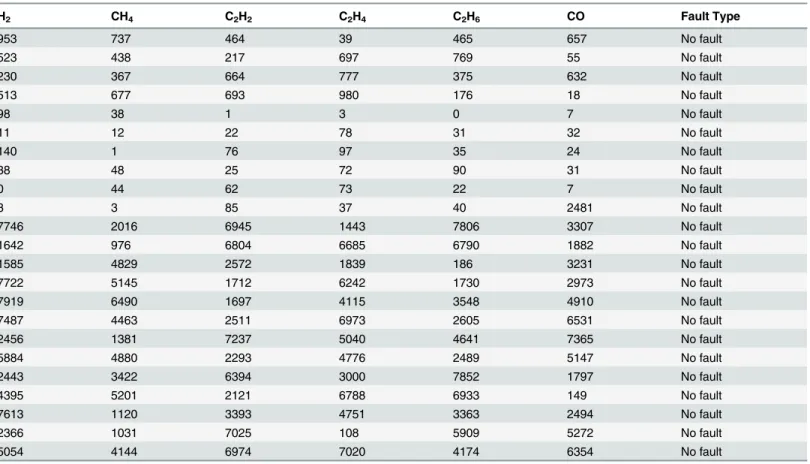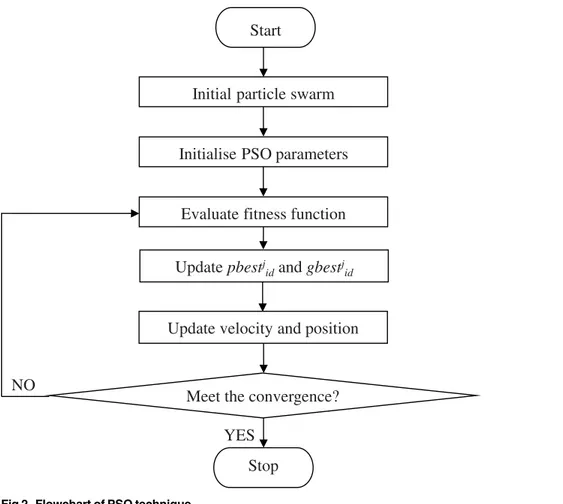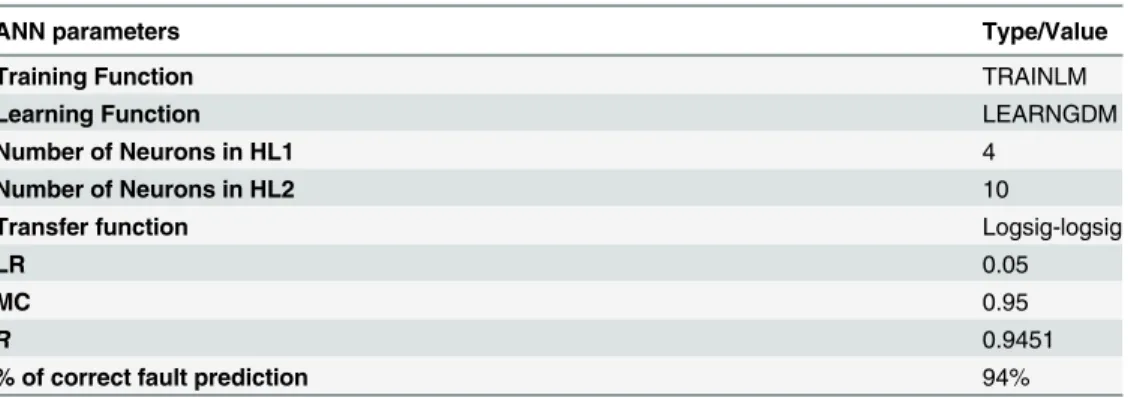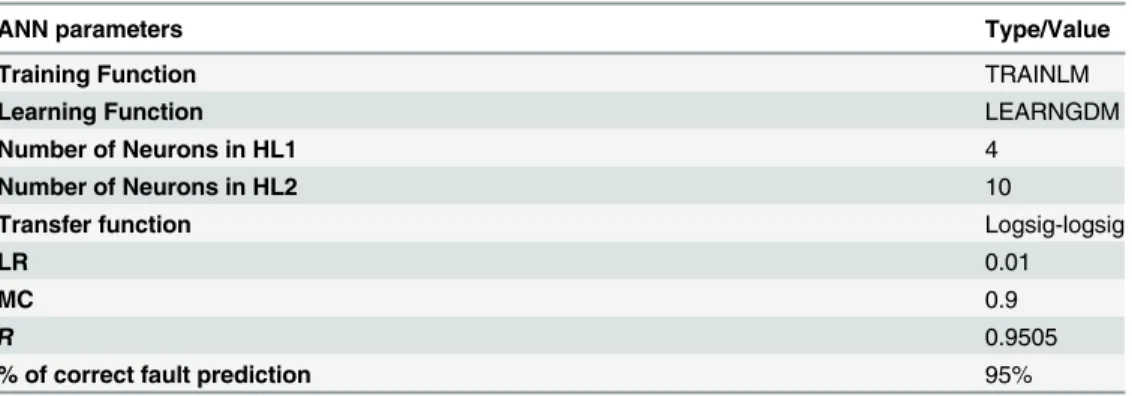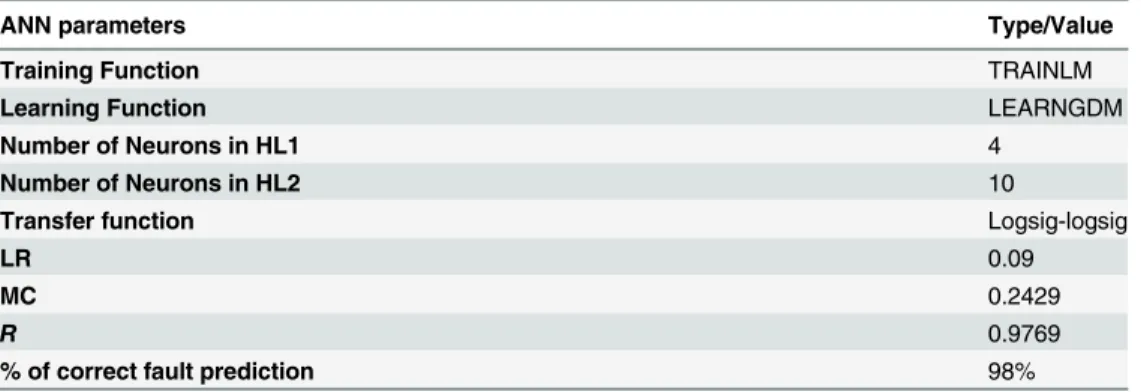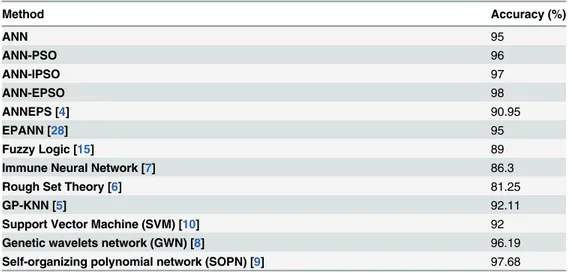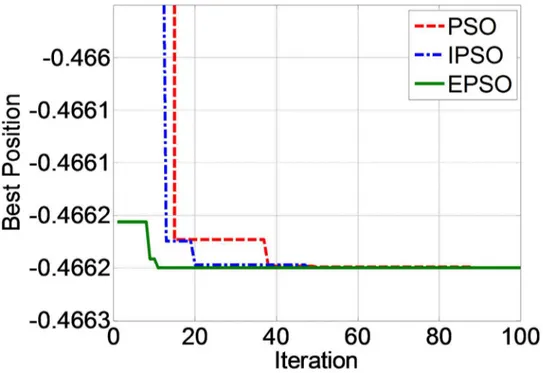Transformer Incipient Fault Prediction Using
Combined Artificial Neural Network and
Various Particle Swarm Optimisation
Techniques
Hazlee Azil Illias1☯*, Xin Rui Chai1☯, Ab Halim Abu Bakar2☯, Hazlie Mokhlis1☯
1Department of Electrical Engineering, Faculty of Engineering, University of Malaya, 50603 Kuala Lumpur, Malaysia,2UM Power Energy Dedicated Advanced Centre (UMPEDAC), Level 4, Wisma R&D UM, University of Malaya, Jalan Pantai Baharu, 59990 Kuala Lumpur, Malaysia
☯These authors contributed equally to this work. *h.illias@um.edu.my
Abstract
It is important to predict the incipient fault in transformer oil accurately so that the mainte-nance of transformer oil can be performed correctly, reducing the cost of maintemainte-nance and minimise the error. Dissolved gas analysis (DGA) has been widely used to predict the incipi-ent fault in power transformers. However, sometimes the existing DGA methods yield inac-curate prediction of the incipient fault in transformer oil because each method is only suitable for certain conditions. Many previous works have reported on the use of intelligence methods to predict the transformer faults. However, it is believed that the accuracy of the previously proposed methods can still be improved. Since artificial neural network (ANN) and particle swarm optimisation (PSO) techniques have never been used in the previously reported work, this work proposes a combination of ANN and various PSO techniques to predict the transformer incipient fault. The advantages of PSO are simplicity and easy implementation. The effectiveness of various PSO techniques in combination with ANN is validated by comparison with the results from the actual fault diagnosis, an existing diagno-sis method and ANN alone. Comparison of the results from the proposed methods with the previously reported work was also performed to show the improvement of the proposed methods. It was found that the proposed ANN-Evolutionary PSO method yields the highest percentage of correct identification for transformer fault type than the existing diagnosis method and previously reported works.
Introduction
Power transformer is one of the important equipment in power systems since the transformer is vital to step-up or step-down the voltage and isolation of the electrical power. Thus, trans-former breakdown may interrupt the power systems. The transtrans-former fault leads to the
a11111
OPEN ACCESS
Citation:Illias HA, Chai XR, Abu Bakar AH, Mokhlis H (2015) Transformer Incipient Fault Prediction Using Combined Artificial Neural Network and Various Particle Swarm Optimisation Techniques. PLoS ONE 10(6): e0129363. doi:10.1371/journal.pone.0129363
Academic Editor:Daqing Li, Beihang University, CHINA
Received:February 9, 2015
Accepted:May 7, 2015
Published:June 23, 2015
Copyright:© 2015 Illias et al. This is an open access article distributed under the terms of theCreative Commons Attribution License, which permits unrestricted use, distribution, and reproduction in any medium, provided the original author and source are credited.
Data Availability Statement:All relevant data are within the paper.
electrical and thermal stresses, which will eventually cause the breakdown of insulating materi-als and the release of gaseous decomposition products respectively. Corona, sparking, arcing and overheating are subject to fault related gases released including hydrogen (H2), methane
(CH4), acetylene (C2H2), ethylene (C2H4), ethane (C2H6) and carbon monoxide (CO) [1,2].
Thus, transformer maintenance is very important and proper monitoring on the trans-former condition will help to avoid the breakdown of transtrans-former. Transtrans-former oil condition monitoring is one of the fundamental methods in maintaining power transformers. The oil test types can be categorised into physical, chemical, electrical and environment type. Among all the tests, the chemical test, dissolved gas analysis (DGA) is commonly used which diagnose the faults based on certain ratio of dissolved gas in oil sample [3]. The existing methods of DGA are key gas method, Doenernberg’s ratio method, Roger’s ratio method and IEC method.
DGA methods involve processing data of the transformer oil sample and fault recognition through annalist experience and ability. However, the main problems with the existing DGA methods are it relies heavily on the experts and the actual site testing has shown that different DGA methods lead to different fault type. Hence, research on reliable techniques to diagnose the transformer fault is actively ongoing.
Since the past, there have been many works conducted on the applications of artificial intel-ligence and optimisation in condition monitoring on power system components and fault diag-nosis, including transformer incipient fault diagnosis [4–10]. These include artificial neural network (ANN), fuzzy logic, rough set theory, support vector machine (SVM) and genetic programming.
One of the most widely used artificial intelligence methods in transformer fault prediction is artificial neural network (ANN) [1,11,12]. ANN is widely used due to it can learn from the training data directly and the complexity of computation in ANN is less. It is also adaptive, able to handle various nonlinear relationships and can generalize solutions for a new data set [13]. ANN directly implements the association process of inputs, where for transformer incipi-ent fault prediction, it is the gas concincipi-entration and the outputs or fault type. Hence, physical model and a predefined correspondence function are not required. However, the convergence is slow and sometimes oscillation occurs. Also, the parameters of the ANN, such as the number of neuron and hidden layer, must be properly chosen in order to obtain the best performance of the network.
Many researches have been performed on the use of ANN in DGA methods to facilitate the detection of transformer incipient fault [11,14]. The input and output from the DGA results of transformer oil were used to train a neural network and identify the fault type from the trained network. Although the use of ANN in transformer incipient fault detection seems to be reason-able, the chosen ANN parameters might not yield the best accuracy of the network output.
In one of the previous works, ANN was combined with the knowledge based of expert sys-tem for transformer fault diagnosis from DGA analysis [4]. The combination of both methods yields better performance than each method being used individually. This is due to the combi-nation of the ANN and expert system takes advantage of superior features of each method and allows them to dominate different fault diagnosis. The usage of fuzzy logic has shown that the fault type of transformer can be obtained efficiently [15]. Fuzzy logic was applied as practical representation of the relationship between the gas content levels and fault type and with fuzzy membership functions. A combination of three fuzzy methods shows that the accuracy of the method is higher than a single fuzzy system in identifying the transformer fault type.
Combination of Artificial Immune System (AIS) and ANN was proposed in [7] to assess the transformer fault type based on DGA analysis. The AIS was used to determine the centers of the Radial Basis Function Neural Network (RBFNN). It was shown that the combination of AIS and RBFNN yields better transformer diagnosis accuracy than random selection and
k-means clustering in determining the RBFNN hidden centers. Other neural network applica-tion has also been employed to improve the diagnostic accuracy of power transformer fault classification based on DGA analysis. Bootstrap and genetic programming (GP) feature extrac-tion were combined with ANN and KNN classifiers [5]. The bootstrap eliminated the less fault type samples in the DGA data. Then, the features of the DGA data extracted with GP were used as the inputs in ANN and KNN classifiers. It was reported that bootstrap and GP com-bined with KNN yields a higher accuracy of transformer fault classification.
Genetic wavelets network (GWN) was proposed to enhance the existing DGA methods for transformer incipient fault identification [8]. The method combined genetic algorithm (GA), wavelet and ANN. GA was used to determine the optimal parameters of GWNs to achieve the best diagnostic DGA model. The wavelet transform property and the decomposed data feature extracted important information from the input data. It was reported that the proposed GWN method yields the best classification for the transformer fault identification compared to with-out wavelet transform.
Self-organizing polynomial networks (SOPN) was proposed as an intelligent decision mak-ing for the transformer fault diagnosis [9]. In this technique, the problem is heuristically for-mulated into a hierarchical architecture with several layers of simple low-order polynomial functional nodes. The networks handled the complicated and uncertain relationships of DGA data from transformer oil samples. The work reported that the proposed method yields far superior performance than the conventional DGA and ANN classification methods.
Although many previous works have reported on the use of intelligence methods to predict the transformer oil faults, it is believed that the accuracy of the previously proposed methods can still be improved. Since artificial neural network (ANN) and particle swarm optimisation (PSO) techniques have never been reported in the previous literature, a combination of ANN and various PSO techniques to predict the transformer incipient fault are proposed in this work. The advantages of PSO are simplicity and easy implementation. In this work, the possi-bility of using various particle swarm optimisation (PSO) techniques with ANN in identifying the transformer incipient fault is explored.
PSO is an evolutionary algorithm that is widely implemented in optimisation problems [16–19]. The thought process behind the algorithm was inspired by the social behaviour of ani-mals, such as bird flocking or fish schooling [20–23]. PSO is a population based search algo-rithm characterized as conceptually simple, easy to implement, computationally efficient, rapid convergence and has the ability to avoid the local minima in a successful way. Hence, these characteristics are advantageous to complex optimisation problems which use huge number of parameters and have difficulty in obtaining the analytical solutions.
In this work, the PSO optimisation methods used are conventional PSO method, iteration PSO (IPSO) and evolutionary PSO (EPSO) method. The percentage of correct prediction of transformer incipient fault from the proposed methods was compared with each other and also with the methods which use only ANN technique and the existing DGA technique. The results from the proposed methods were also compared with the previously reported work to show the improvement of the proposed methods. Hence, the best type of PSO method combined with ANN could be identified, which may improve the transformer incipient fault diagnosis.
Artificial Neural Network (ANN)
ANN is a computational model to imitate the biological neural networks, which consists of inter-connected neurons in order to compute the output from the input. ANN is widely used due to its ability to interpolate and extrapolate from the experience of analysing the data and able to reveal highly nonlinear input-output relationship [24]. Since the condition of electrical systems changes, ANN can adapt itself to new state and put the new state into new training [25]. Hence, ANN is a good approach to compute the relationship, which is difficult to describe explicitly. In this work, the neural network was developed in MATLAB programming language.
Input and output data
In designing ANN, the selection of input, output and network topology is subject to perfor-mance of the ANN model [26]. The data of the gas compositions with respect to the incipient transformer fault were obtained from the actual data of an electrical utility. The design of ANN can be divided into two stages; the training and testing. The flowchart of the development of ANN is shown inFig 1.Table 1shows some of the actual data of incipient transformer fault from an electrical utility that were used in this work.
Training Stage
Firstly, the input data and target data are imported into the network. The gas composition was set as the input and the transformer incipient fault was set as the target. In this work, 100 input data consist of 6 types of gases were used while the fault, which was used as output can be clas-sified into no fault, thermal fault, low intensity and high intensity. These data were categorised into training, validation and testing sets. The training set was 70% of total 100 data and 15% each for validation and test data.
In the training stage, a backpropagation algorithm is a generalised delta rule for feed-for-ward network with multiple of layers. This is due to its possibility to compute the gradient of each layer iteratively by using chain rule [27]. Generally, a sigmoid activation function is used because of its nonlinearity and compatibility with feed-forward backpropagation-learning algorithm to perform better. In this work, the Lavenberg-Marquart (LM) is used as the training function since it is fast, simple and robust algorithm. Thus, feed-forward backpropagation-learning algorithm was set as the network type for ANN architecture of this work.
By tuning the number of hidden layers, number of neurons and transfer function, the best parameters for ANN were selected with the highest accuracy, which equals to,R. A three-layer network which consists of two hidden layers and one output layer was used in this work. Although one hidden layer is enough for nonlinear mapping, a network with two hidden layer is the optimal in iteration number, accuracy and complexity compared to the network with one and three hidden layers. Moreover, three-layer network can overcome the problem of slow rate of training.
Fig 1. Flowchart of ANN algorithm.
Table 1. Some actual data of incipient transformer fault from an electrical utility.
H2 CH4 C2H2 C2H4 C2H6 CO Fault Type
4566 671 683643 434322 45482 2001 High intensity discharge
2323 782 545454 342233 4343 4545 High intensity discharge
2118 844 540711 449264 4443 4535 High intensity discharge
2285 706 546779 435718 4303 4235 High intensity discharge
2238 826 537988 335279 4008 4472 High intensity discharge
2373 817 669150 447061 4284 4807 High intensity discharge
2394 754 673175 360327 4049 4964 High intensity discharge
2423 765 535231 305712 4266 4523 High intensity discharge
2127 825 595394 369165 4456 4931 High intensity discharge
2400 774 647129 315114 4462 4274 High intensity discharge
9750 720 40 11 220 951 Low intensity discharge
9619 780 38 9 220 904 Low intensity discharge
9693 702 38 10 198 928 Low intensity discharge
9439 700 35 10 233 902 Low intensity discharge
9201 744 40 12 226 935 Low intensity discharge
9704 719 39 11 208 982 Low intensity discharge
9823 707 39 8 231 965 Low intensity discharge
9531 744 36 8 220 993 Low intensity discharge
9840 788 37 9 225 991 Low intensity discharge
9032 785 36 12 219 939 Low intensity discharge
3872 6008 2 21315 4772 6811 Thermal fault
4390 5843 3 21102 4474 6894 Thermal fault
3883 5578 2 24716 4797 6947 Thermal fault
4304 6135 5 24999 4508 6648 Thermal fault
4410 5750 5 24560 4630 6988 Thermal fault
3908 5587 5 20537 4315 6658 Thermal fault
3660 5862 2 20487 4590 6715 Thermal fault
3923 6273 5 22803 4624 6759 Thermal fault
4077 6036 2 23232 4469 6710 Thermal fault
4133 5902 4 20449 4608 6772 Thermal fault
4051 5507 3 22825 4330 6599 Thermal fault
4262 5856 2 22286 4689 6825 Thermal fault
200 1000 800 200 875 40 No fault
0 100 3.22 90 0 100 No fault
0 0 0 0 0 0 No fault
0 0 100 0 150 40000 No fault
600 400 280 400 250 300 No fault
600 450 300 800 400 300 No fault
300 50 14 1000 389 65 No fault
487297 271385 179851 459845 333624 97074 No fault
388824 138072 483923 56377 336625 211156 No fault
308142 449556 190961 464427 256989 202072 No fault
441916 269710 7045 478904 116994 313584 No fault
362425 253480 104585 388782 404053 348857 No fault
138560 199740 245667 459335 189531 281963 No fault
362881 260366 218083 144747 239282 209 No fault
206 998 323 709 83 345 No fault
Testing Stage
To test the trained network, a new set of data was simulated. The output of the new data set was simulated using the trained ANN. The best trained network shows that the simulated out-put agrees well with the target outout-put. A regression coefficient,Ris used to determine the per-formance of the trained network.
Particle Swarm Optimisation (PSO)
PSO is a computational optimised technique which was invented by Kennedy and Eberthart in 1995 with the concept of bird flocking and fish schooling behaviour [29]. An optimisation problem can be formulated as a flock of birds fly across an area seeking for spot with abundant food. To find the optimised value, ANN is a time-consuming and difficult on computational process due to its heuristic characteristic. Hence, PSO is a better approach to find the optimised LR and MC values in ANN. In this work, MATLAB programming language was used to exe-cute various PSO algorithms.
In PSO, the population-based search is used to achieve the optimised objective function. Firstly, the potential solution known as particles is initialised randomly and explores in a dimension,dsearch region. With the strategy of each particle updates its velocity and position, the particle swarm will move nearer to the region with higher object value. The flowchart of PSO technique is shown inFig 2. The steps in PSO are explained as follows [30]:
Table 1. (Continued)
H2 CH4 C2H2 C2H4 C2H6 CO Fault Type
953 737 464 39 465 657 No fault
523 438 217 697 769 55 No fault
230 367 664 777 375 632 No fault
513 677 693 980 176 18 No fault
98 38 1 3 0 7 No fault
11 12 22 78 31 32 No fault
140 1 76 97 35 24 No fault
38 48 25 72 90 31 No fault
0 44 62 73 22 7 No fault
3 3 85 37 40 2481 No fault
7746 2016 6945 1443 7806 3307 No fault
1642 976 6804 6685 6790 1882 No fault
1585 4829 2572 1839 186 3231 No fault
7722 5145 1712 6242 1730 2973 No fault
7919 6490 1697 4115 3548 4910 No fault
7487 4463 2511 6973 2605 6531 No fault
2456 1381 7237 5040 4641 7365 No fault
5884 4880 2293 4776 2489 5147 No fault
2443 3422 6394 3000 7852 1797 No fault
4395 5201 2121 6788 6933 149 No fault
7613 1120 3393 4751 3363 2494 No fault
2366 1031 7025 108 5909 5272 No fault
5054 4144 6974 7020 4174 6354 No fault
Step 1: Initialisation
The swarm is initialised by setting the position and the velocity of particles randomly.
Step 2: Evaluate fitness function
The fitness value for each particle with updated position and velocity is calculated.
Step 3: Update
pbest
jidand
gbest
jidThe fitness value of each particle is compared with personal best,pbestjid. If the new fitness value is better than thepbestjid, this value will be set aspbestjidand the current position of particle,Xjid. Among the entire particle, the best fitness value will be set asgbestjidor global best value.
Step 4: Update velocity and position
The velocity and position of all particles are updated using
Vidj
þ1
¼wVidjþc1r1ðpbestidj XidjÞ þc2r2ðgbestidj XidjÞ ð1Þ
Xid jþ1
¼Xid jþV
id jþ1
ð2Þ
where
Fig 2. Flowchart of PSO technique.
Vidjþ
1
= updated velocity of particle i in dimensiondsearch region
Vidj= velocity of particleiat iterationj
Xidj
þ1
= updated position of particleiin dimensiondsearch region
Xidj= position of particleiat iterationj
c1,c2= acceleration factors
r1,r2= random constant between 0 and 1
w= inertia weight
¼wmax
wmax wmin iterationmax
ðiterationÞ
wmax= maximum weight
wmin= minimum weight
Step 5: Meet the end condition
Steps 2–4 are repeated until the stopping criterion is fulfilled such that the best fitness value is achieved or the number of iteration has been reached to its maximum. In this work,c1andc2
were both set as 0.7,wmaxandwminwere set as 0.9 and 0.4 the iteration was set as 100. These are the common values used in most of the PSO algorithms.
Iteration particle swarm optimisation (IPSO)
PSO is easy to trap in the local minimum. Thus, improved PSO algorithm has been suggested for better performance, called as iteration PSO (IPSO) [31]. In IPSO, the best iteration,Ijbest,dis employed to improve the basic PSO performance in term of accuracy. The equation for the velocity inEq (1)is modified as follows [32]:
Vid jþ1
¼wVid jþc
1r1ðpbestid
j X id
jÞ þc
2r2ðgbestid
j X id
jÞ þc
3r3ðIbest;d
j X id
jÞ ð3Þ
where
Ibest;d
j= bestfitness value which obtained by any particle in iterationj
c3= weight of stochastic acceleration term to attract each particle towardIbest;d
j
c3 ¼c1½1 expð c1 ðiterationÞÞ ð4Þ
Evolutionary Particle Swarm Optimisation (EPSO)
EPSO is an optimisation technique which combines the concept of evolutionary strategies and PSO. The main advantage of EPSO is that the search of particle would not be focused on the region of global best fitness value, but the optimum may be in the neighbourhood if the optimal value has not been found. The concept of duplication, mutation and reproduction is employed in EPSO. For duplication, each particle is duplicated. Next, each particle with mutated weight
wwill reproduce an offspring by abiding the particle movement rule. The equation for the velocity inEq (1)is modified as follows [33]:
Vid jþ1
¼wi0
Vid jþw
i1
ð
pbestid j X
id jÞ þw
i2
ð
gbestid
Xid
jÞ ð5Þ
where
gbestid
¼gbest
id
jþt0Nð0
;1Þis the mutated global best position wik ¼wikþtNð0;1Þis the mutated weight
N(0,1) = a random variable with Gaussian distribution with 0 mean and variance of 1 In this work,τandτ’were varied from 0.1 to 0.9 until the best output from the ANN was achieved. It was found that the most suitable value for bothτandτ’is 0.3.
Diagnosis Results
Fault prediction using IEC 60599 method
100 data were used in this work and classified into electrical fault, thermal fault and no fault with 32 cases, 16 cases and 50 cases respectively. IEC 60599 method was used to predict the fault by using the gas ratio. The results are tabulated inTable 2. Comparing the indicated fault with the actual fault occurred, IEC 60599 achieve 70% correct prediction of the transformer fault.
Fault prediction using ANN alone
The simulations were performed by using different number of hidden layer, number of neu-rons, learning rate (LR) and momentum constant (MC) in the ANN. The process of finding the best ANN model is as follows:
1. Variation of number of neurons in hidden layer (HL). Before determining the param-eters of LR and MC, typical values of LR and MC were used as 0.05 and 0.95 respectively. The training function and learning function used were Lavenberg-Marquart (TRAINLM) and Gra-dient Descent with momentum weight and bias learning function (LEARNGDM). The number of neurons in HL1 was increased from 2 to 20 with a step of 2 by keeping other parameters con-stant. The transfer functions of HL1 and HL 2 were logsig-logsig while the transfer function for output layer was pure-linear (PURELIN).
The next stage was increasing the number of neurons in HL2 from 2 to 20 with a step of 2 by keeping other parameters constant. 100 set of data with different number of neurons in HL1 and HL2 were tested. The ANN model with the highestRvalue was selected as shown in
Table 3. The number of neurons for HL1 and HL2 was selected as 4 and 10 respectively since
Table 2. Comparison of the indicated result by IEC 60599 with the actual result.
Fault type Actual fault IEC 60599 method
Electrical Fault 32 31
Thermal Fault 16 15
No fault 50 24
Correct prediction (%) 100% 70%
doi:10.1371/journal.pone.0129363.t002
Table 3. Properties of the selected ANN using default LR and MC.
ANN parameters Type/Value
Training Function TRAINLM
Learning Function LEARNGDM
Number of Neurons in HL1 4
Number of Neurons in HL2 10
Transfer function Logsig-logsig
LR 0.05
MC 0.95
R 0.9451
% of correct fault prediction 94%
higher number of neurons than these values do not yield any further improvement in the net-work performance.
2. Variation of LR and MC values. By keeping MC constant, the value of LR was increased from 0 to 0.9 with a step of 0.01. For each LR, the value of MC was increased from 0 to 0.9 with a step of 0.1. The outcome from this neural network is shown inTable 4.
Fault prediction using ANN with Particle Swarm Optimisation (PSO)
In order to find the optimised value of LR and MC in ANN, PSO was employed. Since there are two parameters need to be optimised, LR and MC were defined asparticle1andparticle2
respectively in the PSO. Using PSO, the optimised result for LR, MC and the best position were obtained. The simulation process of PSO was run for 20 times to test the robustness of the method. Next, the ANN was trained with the data obtained from the PSO. The results from the ANN-PSO method are shown inTable 5.
Fault prediction using ANN combined with iteration PSO (IPSO)
The ANN model was also combined with IPSO. The IPSO technique was used to obtain the optimised values of LR and MC. Similar process as ANN-PSO method was repeated for ANN-IPSO method. The optimised value of LR and MC,Rvalue and the percentage of correct fault prediction obtained from this method are shown inTable 6.
Table 4. The properties of selected ANN after tuning LR and MC.
ANN parameters Type/Value
Training Function TRAINLM
Learning Function LEARNGDM
Number of Neurons in HL1 4
Number of Neurons in HL2 10
Transfer function Logsig-logsig
LR 0.01
MC 0.9
R 0.9505
% of correct fault prediction 95%
doi:10.1371/journal.pone.0129363.t004
Table 5. Properties of the selected ANN combined with PSO.
ANN parameters Type/Value
Training Function TRAINLM
Learning Function LEARNGDM
Number of Neurons in HL1 4
Number of Neurons in HL2 10
Transfer function Logsig-logsig
LR 0.09
MC 0.5579
R 0.9578
% of correct fault prediction 96%
Fault prediction using ANN combined with evolutionary PSO (EPSO)
The ANN model was also combined with EPSO. The EPSO technique was used to obtain the optimised values of LR and MC. Similar process as ANN-PSO method was repeated for ANN-EPSO. The results obtained from the ANN-EPSO method are shown inTable 7.
Comparison between ANN, ANN-PSO, ANN-IPSO and ANN-EPSO
methods
In order to identify the best technique to predict the transformer incipient fault, the ANN alone, ANN combined with PSO, IPSO and EPSO techniques were compared in terms ofR
value, percentage of correct fault prediction and convergence rate. FromTable 8, it can be seen clearly that the ANN-EPSO technique yields the highestRvalue and percentage of correct fault prediction, followed by the ANN-IPSO technique, ANN-PSO technique and finally the ANN only. All of these methods yield higher correct prediction of transformer incipient fault than the existing DGA method, which is IEC method.Rvalue for the ANN alone is the least because ANN is heuristic in nature. In EPSO technique, the value of LR and MC obtained underwent duplication, mutation and reproduction. Thus, ANN with EPSO yields the best results in iden-tifying the transformer incipient fault compared to ANN, ANN-PSO and ANN-IPSO
techniques.
The proposed methods were also compared with the existing methods that have been reported in literature.Table 9summarises the comparison results. From this table, it can be seen that the proposed ANN-EPSO yields the highest percentage of correct transformer
Table 6. Properties of the selected ANN combined with IPSO.
ANN parameters Type/Value
Training Function TRAINLM
Learning Function LEARNGDM
Number of Neurons in HL1 4
Number of Neurons in HL2 10
Transfer function Logsig-logsig
LR 0.09
MC 0.6806
R 0.9644
% of correct fault prediction 97%
doi:10.1371/journal.pone.0129363.t006
Table 7. The properties of selected ANN combined with EPSO.
ANN parameters Type/Value
Training Function TRAINLM
Learning Function LEARNGDM
Number of Neurons in HL1 4
Number of Neurons in HL2 10
Transfer function Logsig-logsig
LR 0.09
MC 0.2429
R 0.9769
% of correct fault prediction 98%
identification. Although EPSO is simple and easy to be implemented, it yields the best result when combined with ANN. In EPSO, the search of particle would not be focused on the region of global best fitness value, but the optimum value may be in the neighbourhood if the optimal value is not found.
A graph of the best position against iteration for ANN with each PSO technique is shown in
Fig 3. From this figure, it can be seen that the convergence rate of EPSO is the fastest, followed by the IPSO and PSO.Fig 4shows a closer view ofFig 3at the convergence zone. From this fig-ure, PSO, IPSO and EPSO converged to the best position at -0.46625. The iteration where each method converges to the best position is shown inTable 8.
Conclusions
In transformer incipient fault recognition, the relationship between gas type and fault is non-linear. This causes problem in the convergence rate and oscillation in artificial neural network (ANN). The parameters of the ANN must also be properly tuned in order to obtain the best performance of the network. To overcome these problems, in this work, a method of combina-tion of artificial neural network (ANN) and various particle swarm optimisacombina-tion (PSO) tech-niques to predict transformer incipient fault has been successfully proposed. In this method, the ANN was used to identify the transformer incipient fault and various techniques of PSO were applied to optimise the performance of the ANN. The performance of various PSO tech-niques in combination with ANN was compared with the existing DGA method, ANN alone and previously reported work to identify the best method for transformer incipient fault
Table 8. Comparison of the results between different techniques.
Parameters ANN ANN-PSO ANN-IPSO ANN-EPSO
LR 0.01 0.09 0.09 0.09
MC 0.9 0.5579 0.6806 0.2429
R 0.9505 0.9578 0.9644 0.9769
% of correct prediction 95% 96% 97% 98%
Convergence (iteration) - 38 20 11
doi:10.1371/journal.pone.0129363.t008
Table 9. Comparison of the proposed methods with previous methods.
Method Accuracy (%)
ANN 95
ANN-PSO 96
ANN-IPSO 97
ANN-EPSO 98
ANNEPS [4] 90.95
EPANN [28] 95
Fuzzy Logic [15] 89
Immune Neural Network [7] 86.3
Rough Set Theory [6] 81.25
GP-KNN [5] 92.11
Support Vector Machine (SVM) [10] 92
Genetic wavelets network (GWN) [8] 96.19
Self-organizing polynomial network (SOPN) [9] 97.68
prediction. It was found that the method of combination of ANN with evolutionary PSO (EPSO) yields the best performance in the transformer fault prediction compared to the exist-ing DGA method and previously reported works. Hence, this method can be proposed as one of the solutions in the field diagnosis of transformer incipient fault.
Fig 3. Best position vs. iteration for PSO, IPSO and EPSO techniques.
doi:10.1371/journal.pone.0129363.g003
Fig 4. Best position vs. iteration for PSO, IPSO and EPSO techniques (closer view).
Acknowledgments
The authors thank the Malaysian Ministry of Education and University of Malaya, Malaysia for supporting this work through HIR research grant (grant no.: H-16001-D00048).
Author Contributions
Conceived and designed the experiments: HAI XRC AHAB HM. Performed the experiments: HAI XRC AHAB HM. Analyzed the data: HAI XRC AHAB HM. Contributed reagents/materi-als/analysis tools: HAI XRC AHAB HM. Wrote the paper: HAI XRC AHAB HM. Checked English language: HAI AHAB HM.
References
1. Zhang Y, Ding X, Liu Y, Griffin PJ. An artificial neural network approach to transformer fault diagnosis. IEEE Transactions on Power Delivery. 1996; 11: 1836–1841.
2. IEEE Guide for the Interpretation of Gases Generated in Oil-Immersed Transformers. IEEE Std C57.104–2008 (Revision of IEEE Std C57.104–1991). 20091–36.
3. Siva Sarma DVSS, Kalyani GNS. ANN approach for condition monitoring of power transformers using DGA. IEEE Region 10 Conference. 2004: 444–447 Vol. 3.
4. Zhenyuan W, Yilu L, Griffin PJ. A combined ANN and expert system tool for transformer fault diagnosis. IEEE Power Engineering Society Winter Meeting. 2000: 1261–1269 vol.2.
5. Shintemirov A, Tang W, Wu QH. Power Transformer Fault Classification Based on Dissolved Gas Anal-ysis by Implementing Bootstrap and Genetic Programming. IEEE Transactions on Systems, Man, and Cybernetics, Part C: Applications and Reviews. 2009; 39: 69–79.
6. Setiawan NA, Sarjiya, Adhiarga Z. Power transformer incipient faults diagnosis using Dissolved Gas Analysis and Rough Set. International Conference on Condition Monitoring and Diagnosis. 2012: 950– 953.
7. Malabanan DR, Nerves AC. Power transformer condition assessment using an immune neural network approach to Dissolved Gas Analysis. IEEE Region 10 Conference. 2014: 1–6.
8. Huang YC. Fault identification of power transformers using genetic-based wavelet networks. IEE Pro-ceedings-Science, Measurement and Technology. 2003; 150: 25–29. PMID:16468926
9. Hong-Tzer Y, Yann-Chang H. Intelligent decision support for diagnosis of incipient transformer faults using self-organizing polynomial networks. IEEE Transactions on Power Systems. 1998; 13: 946–952.
10. Mehta AK, Sharma RN, Chauhan S, Saho S. Transformer diagnostics under dissolved gas analysis using Support Vector Machine. International Conference on Power, Energy and Control. 2013: 181– 186.
11. Bhattacharya SK, Smith RE, Haskew TA. A neural network approach to transformer fault diagnosis using dissolved gas analysis data. North America Power Symposium. 1993
12. Yang HT, Huang YC. Intelligent decision support for diagnosis of incipient transformer faults using self-organizing polynomial networks. IEEE Transactions on Power Delivery. 1998; 13: 946–952.
13. Hammestrom P. Neural networks at work. IEEE Spectrum. 1993
14. Ding X, Yao E, Liu Y, Griffin PJ. ANN based transformer fault diagnosis using gas-in-oil analysis. North America Power Symposium. 1994
15. Ahmed MR, Geliel MA, Khalil A. Power transformer fault diagnosis using fuzzy logic technique based on dissolved gas analysis. Mediterranean Conference on Control & Automation. 2013: 584–589.
16. Garg H, Rani M. An approach for reliability analysis of industrial systems using PSO and IFS technique. ISA Transactions. 2013; 52: 701–710. doi:10.1016/j.isatra.2013.06.010PMID:23867122
17. Hsu C-C, Lin G-Y. Digital redesign of uncertain interval systems based on time-response resemblance via particle swarm optimization. ISA Transactions. 2009; 48: 264–272. doi:10.1016/j.isatra.2009.01.
008PMID:19254796
18. Poultangari I, Shahnazi R, Sheikhan M. RBF neural network based PI pitch controller for a class of 5-MW wind turbines using particle swarm optimization algorithm. ISA Transactions. 2012; 51: 641–648. doi:10.1016/j.isatra.2012.06.001PMID:22738782
20. Liu C, Du W-B, Wang W-X. Particle Swarm Optimization with Scale-Free Interactions. PLoS ONE. 2014; 9: e97822. doi:10.1371/journal.pone.0097822PMID:24859007
21. Andras P. A Bayesian Interpretation of the Particle Swarm Optimization and Its Kernel Extension. PLoS ONE. 2012; 7: e48710. doi:10.1371/journal.pone.0048710PMID:23144937
22. Zhang J, Zhang C, Chu T, Perc M. Resolution of the Stochastic Strategy Spatial Prisoner's Dilemma by Means of Particle Swarm Optimization. PLoS ONE. 2011; 6: e21787. doi:10.1371/journal.pone. 0021787PMID:21760906
23. Hamadneh N, Khan WA, Sathasivam S, Ong HC. Design Optimization of Pin Fin Geometry Using Parti-cle Swarm Optimization Algorithm. PLoS ONE. 2013; 8: e66080. doi:10.1371/journal.pone.0066080
PMID:23741525
24. Zhenyuan W, Yilu L, Griffin PJ. A combined ANN and expert system tool for transformer fault diagnosis. IEEE Power Engineering Society Winter Meeting, 2000. 2000: 1261–1269 vol.2.
25. Gracia J, Mazon AJ, Zamora I. Best ANN structures for fault location in single-and double-circuit trans-mission lines. IEEE Transactions on Power Delivery. 2005; 20: 2389–2395.
26. Seifeddine S, Khmais B, Abdelkader C. Power transformer fault diagnosis based on dissolved gas anal-ysis by artificial neural network. International Conference on Renewable Energies and Vehicular Tech-nology. 2012: 230–236.
27. Guardado JL, Naredo JL, Moreno P, Fuerte CR. A comparative study of neural network efficiency in power transformers diagnosis using dissolved gas analysis. IEEE Transactions on Power Delivery. 2001; 16: 643–647.
28. Zakaria F, Johari D, Musirin I. Optimized Artificial Neural Network for the detection of incipient faults in power transformer. IEEE International Power Engineering and Optimization Conference. 2014: 635– 640.
29. Weidong J, Keqi W. An improved particle swarm optimization algorithm. International Conference on Computer Science and Network Technology. 2011: 585–589.
30. Xiaoxia W, Tao W, Bingshu W. Hybrid PSO-BP Based Probabilistic Neural Network for Power Trans-former Fault Diagnosis. Second International Symposium on Intelligent Information Technology Appli-cation, 2008. IITA '08. 2008: 545–549.
31. Changxin L, Chunjuan O, Ping Z, Weidong T. An Adaptive Fuzzy Weight PSO Algorithm. International Conference on Genetic and Evolutionary Computing. 2010: 8–10.
32. Abdullah MN, Bakar AHA, Rahim NA, Jamian JJ, Aman MM. Economic dispatch with valve point effect using iteration particle swarm optimization. International Universities Power Engineering Conference (UPEC). 2012: 1–6.
